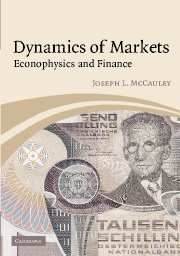Book contents
- Frontmatter
- Contents
- Preface
- 1 The moving target
- 2 Neo-classical economic theory
- 3 Probability and stochastic processes
- 4 Scaling the ivory tower of finance
- 5 Standard betting procedures in portfolio selection theory
- 6 Dynamics of financial markets, volatility, and option pricing
- 7 Thermodynamic analogies vs instability of markets
- 8 Scaling, correlations, and cascades in finance and turbulence
- 9 What is complexity?
- References
- Index
9 - What is complexity?
Published online by Cambridge University Press: 31 October 2009
- Frontmatter
- Contents
- Preface
- 1 The moving target
- 2 Neo-classical economic theory
- 3 Probability and stochastic processes
- 4 Scaling the ivory tower of finance
- 5 Standard betting procedures in portfolio selection theory
- 6 Dynamics of financial markets, volatility, and option pricing
- 7 Thermodynamic analogies vs instability of markets
- 8 Scaling, correlations, and cascades in finance and turbulence
- 9 What is complexity?
- References
- Index
Summary
Economists teach that markets can be described by equilibrium. Econophysicists teach that markets are very far from equilibrium and are dynamically complex. In our analysis of financial market data in Chapters 6 and 7 we showed that equilibrium is never a good approximation, that market equilibrium does not and cannot occur, but we did not use any idea of complexity in describing financial markets dynamically. Where, then, does complexity enter the picture if all we have needed so far is simple nonstationary stochastic dynamics?
The complexity of financial markets is hidden in part in the missing theory of the expected return R, which we treated in Chapter 6 as piecewise constant (constant within a trading day), but we neither extracted R empirically nor modeled it theoretically. Imagine trying to write down an equation of motion for R. It is easy to construct simple deterministic and/or stochastic models, and all of them are wrong empirically. In order to get the time development of R right, you have to describe the collective sentiment of the market within a given time frame, and that collective sentiment can change suddenly due to political and/or business news.
The other part of complexity of financial markets is that the empirical distribution is not fixed once and for all by any law of nature. Rather, it is also subject to change with agents' collective behavior, but the time scale for the entire distribution to change its functional form can be much greater than the time scale for changes in the expected return. The only empirical method for estimating the expected return is to assume that the future will be like the past, which ignores complexity altogether.
- Type
- Chapter
- Information
- Dynamics of MarketsEconophysics and Finance, pp. 185 - 200Publisher: Cambridge University PressPrint publication year: 2004



